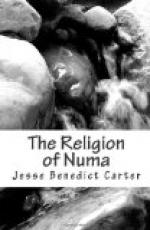The Sibylline books had aroused these feelings, a knowledge of the oracle at Delphi had increased them, the rites of Aesculapius had carried them farther, but it was not until the Magna Mater came that they seem to have burst forth in any large degree. But aside from the rapid growth of the Magna Mater cult itself we have in this second century two instances of this tendency. The first was connected with the god Dionysos-Liber, innocent enough at his first reception in B.C. 493, in the company of Demeter-Ceres and Kore-Libera. To be sure the state had introduced him merely as the god of wine, but the mystery element in Dionysos took firm hold on private worship, and the Bacchanalian clubs or societies began to spread over Italy. In the course of about three centuries they had become a formidable menace to the morals and even the physical security of the inhabitants of Rome. Their meetings instead of occurring three times a year took place five times a month, and finally in B.C. 186 the famous Bacchanalian trial took place, of which Livy (Bk. xxxix.) gives such a graphic account, and to which a copy of the inscription of the decree of the Senate, preserved to our day, gives such eloquent testimony, providing as it does severe penalties for subsequent offenders, and recognising on the other hand large liberty of conscience.
The same love of mystery and longing for knowledge which produced the Bacchanalian clubs accorded a warm reception to astrology and made men listen with eagerness to those who could tell their fortunes or guide their lives by means of the stars. We do not know when the bearers of this knowledge first arrived in Rome, but Cato, in his Farm Almanac, our earliest piece of prose literature, in giving rules for the behaviour of the farm bailiff especially enjoins the intending landowner that his bailiff should not be given to the consultation of Chaldaean astrologers. Within half a century the problem of the Chaldaeans grew so serious that state interference was necessary, and in B.C. 139 the praetor Cn. Cornelius Hispalus issued an edict ordering the Chaldaeans to leave Rome and Italy within ten days.
The same age which produced this growth of superstition brought also the antidote for it in the shape of a sceptical philosophy, but the only trouble was that this philosophy not only cured superstition but in doing so killed the genuine religious spirit underlying it. It cast out, to be sure, the seven devils of superstition, but when men returned to themselves again, they found their whole spiritual house swept and garnished. With the death of the direct pupils of Aristotle, the Greek mind had thought out all the problems of philosophy of which man at that time was able to conceive. The following generations of philosophers devoted themselves either to the elaboration of detail or to a renewed examination of the foundations of belief, with the result that their smaller minds came to smaller conclusions, and the end of their investigations was one increased scepticism. The schools of the day showed many slight variations and bore many different names, but they all agreed in being more or less pervaded by a sceptical spirit, and by accenting ethics as against metaphysics, though they defined ethics very differently according to their starting point.




